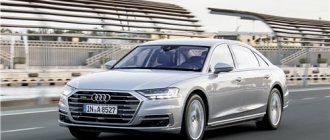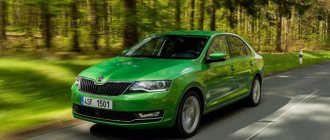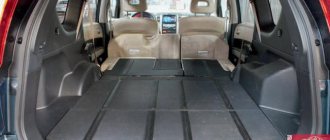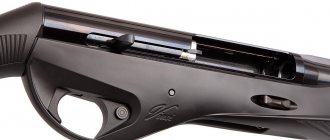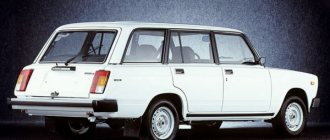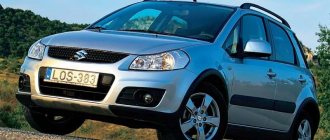12 February 2021 Lada.Online 1 582 2
At the beginning of 2021, sales of Lada Niva Travel began. In appearance, the modern SUV has almost 30 years of history. More than 650 thousand of these cars today drive on roads and off-roads in Russia and other countries. The newspaper “VA-Volzhsky Avtostroitel” told about the history of this SUV.
In 1993
AVTOVAZ has officially launched the development of a second-generation SUV, which would incorporate the experience of creating and operating the VAZ-2121 Niva model. The project was assigned the factory index VAZ-2123. The car received a streamlined body shape and a modernized chassis, which reduced the level of noise and vibration - while the vehicle's cross-country ability remained at a high level.
VAZ-2123 was demonstrated to the general public at the Moscow Motor Show in 1998
, and production began
in 2000
in the pilot production of AVTOVAZ. In total, about 1000 cars were assembled. Production of the VAZ-2123 under the new name Chevrolet Niva began on September 23, 2002. The responsibilities of the joint venture with General Motors were divided in such a way that AVTOVAZ produced the body, engine and chassis (about 70% of the main components in total), and the partners carried out painting and final assembly.
In December 2021
AVTOVAZ has closed a deal to buy out a 50% stake in the GM-AVTOVAZ JV from an American company. Thus, the production site, later renamed LADA WEST TOGLYATTI, became 100% owned by AVTOVAZ, and the Niva model returned to LADA’s product portfolio.
From July 2020
year, the Niva SUV is again produced under the LADA brand: the Volga boat is located on the radiator grille, steering wheel hub and in the graphics of the multimedia system.
Well, in December 2021
the car received a new design and a new name – LADA Niva Travel.
Description of the car
Description of the basic modification L.
| Cars of the Chevrolet Niva family represent a further development of the concept of domestic comfortable SUVs, which began with the VAZ-2121 Niva car. They differ from their predecessors in modern design, increased comfort and more advanced design. |
| VAZ-2123 (Chevrolet Niva) and its modifications are all-terrain passenger cars with a monocoque station wagon body, produced by the GM-AVTOVAZ joint venture. The number of doors is five, the number of seats is five for the L and GLS modifications or four for the LX and GLX modifications. |
| The engine is located longitudinally in front. The transmission is made according to the scheme of permanent all-wheel drive with a locking center differential and a range of multipliers. The front suspension is independent lever-spring, the rear suspension is dependent spring. The front brakes are disc, the rear are drum, the LX and GLX modifications are equipped with an anti-lock braking system (ABS). The ZF power steering is equipped with a steering column position adjustment device. |
| The VAZ-2123 engine with distributed fuel injection, installed on the L and GLS modifications, is developed on the basis of the VAZ-21213 engine and complies with Euro II toxicity standards. The changes affected the gas distribution mechanism: to reduce noise, a single-row chain and a hydraulic chain tensioner were used. For the same purpose, hydraulic valve supports are installed. Some engines are produced in configurations that meet Euro III toxicity standards. These engines use phased fuel injection separately into each cylinder, once every four strokes, and not according to a simplified pairwise scheme. In addition, the exhaust manifold of such engines, to reduce heat capacity, is not made of cast iron, but is welded from stamped steel parts. This design reduces the mass and heat capacity of the manifold, which speeds up the heating of the exhaust gas converter and allows it to be brought into working condition more quickly. For the same purpose, the receiving pipe is thermally insulated with basalt fabric. In the exhaust system of such an engine, two oxygen sensors are installed, before and after the converter, to monitor the efficiency of the engine management system. |
| In essence, the VAZ-2123 engine is a VAZ-21214 engine adapted to the Chevrolet Niva engine compartment. It differs in the shape of the intake tract and the location of the front suspension mounts of the power unit. The position of the supports has been changed in such a way that the center of gravity of the engine is on the line of the supports, in contrast to the VAZ-21413 and VAZ-21414 engines, which are mounted on cantilever supports. |
| The LX and GLX modifications are equipped with a more powerful Opel FAM 1 Z18XE ECOTEC engine, which meets Euro IV toxicity standards. Cars with this engine are equipped with a five-speed Aisin gearbox (Japan), combined into a monoblock with a transfer case. |
| Chevrolet Niva cars of the 2005 model year are available in the following trim levels. |
| Modification L - has an adjustable steering column, fabric upholstery, immobilizer, central locking, fog lights in the bumper, cabin air filter, electric windows, heated exterior mirrors with electric drive, headlight level control, radio preparation and a rubber mat in the radio niche, as well as decorative cover for the spare wheel. |
| The GLS modification is an improved version of the L modification. It has velor upholstery, heated front seats, tinted windows, radio equipment with an antenna and two speakers, alloy five-spoke wheels and a lockable hard spare wheel cover. |
| The LX modification is equipped with a driver airbag and ABS from Bosch. In addition, this version has slightly changed the kinematics of the spring-lever suspension, in which stiffer springs and shock-absorbing struts are used, and the overall ride height of the body has been reduced, which, coupled with the use of lower-profile 16-inch wheels, has improved handling at high speeds. To reduce high-frequency vibrations, the transmission uses lightweight GKN driveshafts with constant velocity joints instead of cardan joints. The brakes have been strengthened: front brakes with ventilated discs, the diameter of the vacuum booster has been increased to 10 inches. |
| The GLX modification is a top version, intended mainly for delivery to foreign countries. In addition to what is listed for the LX modification, it is additionally equipped with a front passenger airbag, Delphi air conditioning and Opel seats. |
| In the future, the GM-AVTOVAZ joint venture plans to install a PSA diesel power unit (for export) and a 1.8-liter diesel engine from the Barnaul plant (for the domestic market) on cars of the Chevrolet Niva family. In addition, in the future it is planned to produce commercial versions with pickup and van bodies. |
On August 1, 2011, JSC "GM - AVTOVAZ" began production of Chevrolet NIVA cars equipped with ABS and a system of front airbags for the driver and front passenger, including a driver's airbag, a front passenger's airbag, seat belts with load limiting and pretensioner, modernized front seats. The change is valid only for the GLS, GLC trim levels.
Question: When will the Anti-Dust package be installed at the factory, and how can I find out if a new car has this package?
Answer: The Anti-Dust package is installed on all Chevrolet NIVA configurations starting from 09/02/2014. and includes a set of products installed in body and interior panels that prevent dust from entering the interior from outside. To find out whether the car is equipped with the Anti-Dust package, you need to pay attention to the last 6 digits in the VIN number. If they are higher in order than 532818, then the car is equipped with this package.
Video
VAZ-2123 Chevrolet Niva history of creation
The history of the Chevrolet Niva began in the third millennium, when representatives of the General Motors concern became interested in the next development of AvtoVAZ - the Niva VAZ-212 3 model. Considering its design promising for the world market, they decided to use the car as a platform for creating inexpensive SUVs . , the General Motors-AVTOVAZ joint venture was created .
The new Niva VAZ-2123 is the first domestic car that can make people shell out money for its appearance alone. It doesn’t seem to have any special design tricks or bells and whistles, but its integrity and harmony are already attractive and beautiful. And it’s not only beautiful, it’s durable, because everything is subject to aging except harmony.
Chevrolet Niva has been produced since 2002, but is already considered an epoch-making achievement of the domestic automobile industry.
The “23rd” has its own face - the original front part: a purely Jeep false radiator grille between teardrop-shaped block headlights, in which, in accordance with the tradition of the brand, the turn signal is placed on top. The rear is also far from ordinary, as evidenced by the glass of the rear door alone, the lower edge of which is made of a step. To the credit of the designers of AVTOVAZ , the new Niva came out visually unlike any foreign analogue; today its appearance is original and devoid of any obvious imitation, worthy of crooked grins, finger pointing and remarks “Ripped off!” So the car will in no way get lost among the many of its competitors of different brands, of which at least a dozen were built abroad over the twenty years of the life of the previous model of the same name.
In its exterior, the VAZ-2123 differs radically from its predecessor - there is nothing to even look for similarities here. Externally, it is a typical city SUV - metallic paint, bumpers painted in body color. It was initially designed as a five-door model, in its basic version, and its three-door version exists only in sketches and mock-ups. Another thing is a two-door pickup truck or van, examples of which have already been built in metal, but there really isn’t a three-door station wagon yet and, quite possibly, there won’t be one at all. However, five doors are not all design and body innovations. The rear door of the new model, unlike the door of the 213th Niva, opens not upward, but to the side. In addition, a spare tire is now hung on its outer side, which was located under the hood of its predecessor.
It is quite natural that due to the slightly increased overall dimensions inside the VAZ-2123 it turned out to be more spacious than the VAZ-21213 . The very spacious interior can comfortably accommodate five people and has a folding rear seat. There are only two seat adjustments, but finding a comfortable position is no problem. Thanks to two rows of doors, getting in and out has been significantly simplified; the protruding fenders of the rear wheels have moved back somewhat and now do not support the second row seat from the sides, which can comfortably accommodate three people. The luggage compartment has also increased by about 1.5 times. Of course, it is not as voluminous as that of full-size SUVs , but in comparison with the trunk of the first generation Niva, progress is obvious. Well, the overall impression of the interior of the cabin is not worth even talking about: it is made at a modern level (there is even a place for an airbag for a passenger in the dashboard) and surpasses the interior of the VAZ-21213 in any of its versions.
The chassis and transmission of the old Niva have remained virtually unchanged structurally - modernized, life-tested units have been used. Here is a list of improvements: the front axle gearbox is “decoupled” from the engine; The design of the gearbox drive has been changed; extended intermediate shaft; the transfer case has fine-meshing gears; front and rear driveshafts are unified.
Compared to its predecessors, changes have been made to the layout of the power unit, front and rear suspension, and steering. The basic model is equipped with electric power steering and an adjustable steering column, an immobilizer and central locking, electric front door windows, headlight range control and radio preparation. For an additional fee, you can get alloy wheels instead of steel, tinted windows, front fog lights, a velor interior with heated front seats, two speakers and an antenna, rear headrests and a spare wheel cover.
In motion , a car is not much different from a simple passenger car. But where the roads end and directions begin, Niva feels at ease. Which is not surprising: from a technical point of view, the car is much more serious than comparable SUVs, which is clearly indicated by the presence of a transfer case and a locking center differential. The downside of a car's is an increased level of noise generated in the depths of the transmission when driving at high speeds, as well as significant vibrations on the gearshift lever. True, accelerating the Chevrolet Niva faster than 135 km/h is not an easy task. But keep an average of 100-110 kilometers and move comfortably. The Chevrolet Niva 's visibility through the front and side windows is quite sufficient, and the thrust of the quiet engine is quite enough to find a gap and join the flow.
The brake system has been seriously modernized, including the design of the master cylinder and brake booster. The changes affected the clutch and gearbox, in which the bearings, gear shift mechanism, as well as all gaskets and seals were replaced.
The engine is based on the well-known “ 21213 ”; it has hydraulic valve lifters and a hydraulic camshaft drive chain tensioner. The camshaft itself has expanded phases, which increased torque at low speeds.
In the basic version, the car is equipped with a 1.7 liter injection engine with a power of only 80 hp. pp., an electronic distributed fuel injection system and an exhaust gas system with a catalytic converter that meets the requirements of Euro-2 and Euro-3 toxicity standards. For a car with a curb weight of 1.35 tons, this power is not enough. Now let’s imagine a Chevrolet Niva with a full load of 1.8 tons. It's 80 liters. With. - nothing at all.
In addition, modifications of the Chevrolet Niva with a GM gasoline engine and a FIAT . It is quite natural, given the prospects for sales in foreign markets, that the model needs several modern engines and, first of all, a diesel engine.
Export version of the Chevrolet Niva (2003) with a more powerful engine from Opel . True, such a car costs much more.
Since 2003, the color range has been expanded to seven colors. Now Chevrolet Niva is equipped with electric exterior mirrors, a cabin air filter and fog lights.
Modifications of VAZ-2123
VAZ-2323 - Pickup truck based on the VAZ-2123 . From the VAZ 2123 , along with the chassis, the mini-trucks borrowed the rear lights, instrument panel, two front seats, doors and front part. The use of lightweight body parts for the rear wall of the body, sides and cargo area made it possible to reduce the curb weight compared to the VAZ 2123. The use of reinforced rear suspension springs made it possible to increase the vehicle's .
VAZ-2723 - Van body. Made on the basis of the V AZ-2323 “pickup”. The car has a plastic cargo compartment superstructure and a two-part rear door.
Niva model on caterpillar tracks
Salon of VAZ-2123 Chevrolet Niva
Model history
The design of a new all-terrain vehicle to replace the Niva began at AvtoVAZ back in the mid-80s. The first concept of the new Niva - VAZ - 2123 was demonstrated in 1998. Due to financial difficulties, AvtoVAZ was never able to establish mass production of the new model and carried out small-scale assembly at the pilot production facilities of AvtoVAZ OJSC from 1998 to 2002. In 2002, the license for the VAZ-2123 and the rights to the Niva brand were sold to General Motors. American engineers made more than 1,000 small changes to the design of the SUV, which allowed the Chevrolet Niva to be considered an independent model. The conveyor belt with the new Niva was launched in September 2002.
From November 2006 to the end of April 2008, about 1000 Chevrolet Niva FAM-1 were produced. The car received the index 21236 and was equipped with an Opel Z18XE engine (122 hp) and a 5-speed Aisin manual transmission with a transfer case in one block.
In March 2009, the model underwent restyling, receiving the factory VAZ index - 212300-55. The Italian design studio “BERTONE” was responsible for updating the appearance of the car.
VAZ-2123
Pre-production stage: VAZ-2123 (1998)
| VAZ-2123 | |||||||||||||||||
| Total information | |||||||||||||||||
| Manufacturer | AVTOVAZ Lada West Tolyatti | ||||||||||||||||
| Years of production | 1998—2002 | ||||||||||||||||
| Assembly | AVTOVAZ (Tolyatti, Russia) | ||||||||||||||||
| Class | SUV | ||||||||||||||||
| Design | |||||||||||||||||
| Body type | 5-door station wagon (5-seater) | ||||||||||||||||
| Layout | front-engine, all-wheel drive, with a center differential lock and range control (I–2.14, II–1.20) | ||||||||||||||||
| Wheel formula | 4 × 4 | ||||||||||||||||
| Transmission | |||||||||||||||||
| 5-speed manual transmission | |||||||||||||||||
| Weight and dimensions characteristics | |||||||||||||||||
| Length | 3900 mm | ||||||||||||||||
| Width | 1700 mm | ||||||||||||||||
| Height | 1640 mm | ||||||||||||||||
| Clearance | 200 mm | ||||||||||||||||
| Wheelbase | 2450 mm | ||||||||||||||||
| Rear track | 1400 mm | ||||||||||||||||
| Front track | 1430 mm | ||||||||||||||||
| Weight | 1300 kg | ||||||||||||||||
| Dynamic characteristics | |||||||||||||||||
| Acceleration to 100 km/h | 17 s | ||||||||||||||||
| Maximum speed | 140 km/h | ||||||||||||||||
| On the market | |||||||||||||||||
| Related | "Lada Kalina", "Lada Niva", VAZ-2120 "Nadezhda" | ||||||||||||||||
| Similar models | UAZ-3160 | ||||||||||||||||
| Segment | J-segment | ||||||||||||||||
| Other information | |||||||||||||||||
| Load capacity | 450 kg | ||||||||||||||||
| Fuel consumption | 10 l | ||||||||||||||||
| Volume of the tank | 58 l | ||||||||||||||||
| Modifications | |||||||||||||||||
| |||||||||||||||||
| VAZ-2723 (van) | |||||||||||||||||
| Years of production | 1998-2002 - pre-production samples of Lada Niva | ||||||||||||||||
| Body type | 2-door van (2-seater) | ||||||||||||||||
| Length | 4150 | ||||||||||||||||
| Height | 1950 | ||||||||||||||||
| Weight | 1350 | ||||||||||||||||
| Load capacity | 450 | ||||||||||||||||
| Acceleration time to 100 km/h | 16 | ||||||||||||||||
VAZ-2323
Many components and assemblies of the VAZ-2123 were borrowed from the previous generation of Niva VAZ-21213/21214. The VAZ-2123 engine was a further development of the VAZ-21214 injection engine with adaptation to the new engine compartment. Modifications with carburetor engines and a 2-liter injection engine with an original transmission were also produced. As a result of the tighter layout of the engine compartment, the spare wheel was hung on the rear door, which, by the way, was more in line with fashion in the SUV segment. The steering used an electric power steering made in Makhachkala, similar to the Lada Kalina car. The plant also used the Elkar (January) distributed injection system on its first cars, which is a hardware clone of the Bosch Motronic system. The front and rear cardan shafts are unified (similar to the short-wheelbase LADA 4x4), the intermediate shaft is extended. The transfer case mount has been changed (a third support has appeared), the center differential lock lever is combined with the range shifter switch lever (the so-called single-lever “transfer case” circuit). The front axle gearbox is separated from the engine. The mounting points for the rear shock absorbers are moved closer to the wheels and mounted vertically. The lower links of the rear axle now form a parallelogram, which reduces steering of the rear axle. At the front, unlike the Chevrolet Niva, there are two towing eyes. Some models were equipped with a steering wheel with a built-in airbag. VAZ engineers also developed an electric headlight range control system instead of a hydraulic one and used it for the first time on this model. Subsequently, this system was transferred to Lada 2110, Lada Priora, Lada Kalina cars.
The family of bodies, in addition to the basic five-door station wagon, also included a VAZ-2323 pickup and a VAZ-2723 van, which did not go into production. The chief designer of the project is Valery Ivanovich Domansky.
First episode: “Chevrolet Niva” (2002)
Niva was produced in two main trim levels: L
and
GLS
. The GLS version is superior in configuration to the L version due to artificial leather interior trim, alloy 16-inch wheel rims, audio equipment, an aluminum spare wheel holder that allows the spare wheel to be hung “face-on”, isothermal tinted windows, fog lights, heated front seats, etc. d.
LC options available
and
GLC
, respectively, similar to the L and GLS trim levels, but equipped with air conditioning.
Without exception, all configurations include audio preparation and electrical control of exterior mirrors (starting from 2004), heated exterior mirrors (starting from 2004).
When bringing the car to the assembly line, General Motors abandoned the electric power steering due to low quality, system malfunctions and supply problems and replaced it with a hydraulic power steering system, with the involvement of ZF and Bosch, which localized its production by establishing it in Tolyatti ( Subsequently, the first generation Niva, as well as the Lada 110, were equipped with pumps from this company.
General Motors pursued the goal of replacing all unreliable components of Project 2123, but not by importing, but by localizing the production of spare parts from AvtoVAZ suppliers, taking into account the experience gained when launching the production of large-unit assembly of the Chevrolet Blazer. Subsequently, the January injection system was replaced by a Bosch Motronic system. The instrument cluster was produced by VDO (instead of the traditional supplier - Vladimir). The seat frame was also changed, it acquired a more reliable design - unlike 2123, on which seats from the Lada 110 were installed. The body ventilation system was also changed, a cabin filter was added. The car began be equipped with an air conditioning and interior recirculation system, as well as electric heating and adjustment of rear-view mirrors. In project 2123, these adjustments were provided only mechanically. Work was also carried out on the wiring of the car, it received a central locking and alarm system, as in the Lada Kalina car, and an immobilizer, although in principle the car's wiring remained from the Lada 110. It was supposed to equip the car with a bad road sensor, but later this idea was abandoned.Later this sensor was installed on the Lada Kalina.
On cars of the first years of production, a VAZ 21214 1.7 liter 4-cylinder in-line petrol engine was used. with distributed fuel injection with a capacity of 79.5 hp. With. (58.5 kW) with a maximum torque of 128 Nm. But, unlike the engine for the first generation Niva, the piston group for assembly was supplied not by the VAZ plant, but by a GM supplier, and the requirements for the engine were higher, although they were assembled on the general AvtoVAZ engine assembly line. Subsequently, the engine was modified for this model and received its index 2123. It was equipped with a different bracket for mounted units with a relocation of the oil filter, a high-power 90A generator with an overhead location for better protection against the ingress of water and dirt. The engine was equipped with a hydraulic chain tensioner and hydraulic compensators to increase the reliability of the design. Subsequently, all these modifications partially spread to the first generation Niva.
- Chevrolet Niva, VAZ-2123 injection engine with a displacement of 1.7 liters
- Chevrolet Niva engine compartment
"Chevrolet Niva" FAM-1
Engine compartment of Chevrolet Niva FAM-1.
The first batch of Chevrolet Niva FAM-1 cars was released in the spring of 2006, production began in November 2006. The car received the VAZ-21236
and was produced in a single trim level,
GLX
. The car was equipped with an Opel Z18XE engine (1.8 l, 122 hp) and a 5-speed manual transmission Aisin AG5, coupled with a transfer case from Niva in a monoblock housing. The Opel Z18XE engine was chosen in connection with the start of production at GM-AvtoVAZ of the Chevrolet Viva. After increasing the torque and replacing the gearbox, it was necessary to change the gear ratios of the up and down range. As well as mounting brackets to the body and pillows of a monoblock design. It was also necessary to change the transfer case housing and plain bearings. The new transfer case housing began to be produced at the Zavolzhsky Motor Plant, and not in Tolyatti at VAZ. The body has not undergone major design changes relative to the base model. However, the entire transmission part of the car was replaced, except for the front and rear axles. The length of the driveshafts also changed.
This modification was equipped with:
- ABS system from Bosch, for which it was necessary to change the design of the rear axle and front wheel hubs;
- TRW 10-inch vacuum brake booster;
- Turkish-made drive shafts with CV joints in the joints;
- air conditioning;
- two airbags (driver and front passenger);
- height-adjustable driver's seat (from Chevrolet Viva);
- seat belt pretensioners.
All these changes allowed the car to gain strength and add comfort for the driver. A significant role was also given to driver safety, which allowed it to score 4 stars out of 5 possible in the crash test of Autoreview magazine using the Euro'n'CAP method, when the base model received only 2. The car was not widely used due to its rather high price relative to the base model, the price was twice as much. Most of the developments on the FAM-1 project were used when restyling the model in 2009. Owners of these modifications generally note higher reliability, lower fuel consumption, less transmission vibration noise, and higher speed and traction characteristics of the model.
GLX modification was discontinued
or
FAM-1
(Chevrolet Niva FAM-1). In two years, only about a thousand Chevrolet Niva FAM-1 were made and sold.
"Chevrolet Niva Trophy"
There is a tuning modification “ Trophy”
"(Chevrolet Niva Trophy)[16], adapted for off-road use. The main differences from the basic configuration include:
- mechanical chain tensioner instead of a hydraulic tensioner;
- installation of a snorkel to avoid water hammer when passing through fords;
- forced shutdown of engine cooling fans;
- transmission breathers are located in the engine compartment;
- self-locking limited-slip differentials are installed in the drive axles;
- the transmission uses main pairs with a gear ratio of 4.3 (instead of 3.9);
- There is a mechanism for attaching an electric winch.
Design of details from (2009)
The model was restyled in 2009, and was developed by the design studio Stile Bertone.[17] Her task was to refresh the model in the style of GM cars. The car received a lensed low beam and a different lighting design. Off-road body kit that protects body parts off-road. As well as a new ceiling design in the cabin, with a courtesy lamp from GM, a steering wheel was installed by TRW, similar in design to the Opel Corsa, but with a VAZ spline for mounting on the steering shaft. Cardan shafts with CV joints, changes in the design of bearings and transfer case seals. And a different shape for the central tunnel in the cabin.
The Chevrolet NIVA is available in 5 trim levels: L, LC, LE, GL, GLC.
In May 2015, the range of model trim levels was expanded with the LE+ version, created on the basis of the GLC version. The car received air conditioning, a full safety package, Continental Cross Contact tires with K&K Camelot wheels, as well as rear bumper protection with a towbar and unpainted moldings.[18]
Since October 12, 2015, all cars are equipped with modernized Euro 5 engines.[19].
- Restyled Chevrolet Niva, L/LC equipment, rear view.
- Dashboard of a restyled car.
Return of the model to Volzhsky Automobile (2020)
The car received basic changes to the platform and became unified with the Lada Niva Urban. The design of the front hub assembly has changed. But most of the changes remained cosmetic; due to the withdrawal of General Motors from the joint venture, the use of their trademark is no longer possible. Therefore, AvtoVAZ, under the contract, removed all references to GM, but did not refuse some of the suppliers.
AvtoVAZ began installing the Era-GLONASS system. A driver's airbag has been added to the basic package in accordance with legal requirements to obtain OTTS.
"LADA Niva Off-Road"
Also in 2021, based on the LE configuration, a modification called Off Road appeared. Features of this configuration are:
- Snorkel;
- Center lockable differential;
- A towbar capable of towing trailers weighing up to 1.2 tons;
- Off-road tires[20].
Second restyling: “Lada Niva Travel” (2021)
On December 21, 2021, it became known that this model had undergone a modified appearance and was also named Lada Niva Travel. The car received a new front end, a new rear bumper and moldings, as well as LED rear lights[21]. There were no technical changes.[22] Sales of the new model started in February 2021[23].
In March 2021, AvtoVAZ announced the completion of production of the old (pre-restyling) Niva, leaving only the Niva Travel on the assembly line[24].
Options[25]
- 1.7 l 8 cl. (80 hp), 5MT / Classic
- 1.7 l 8 cl. (80 hp), 5MT / Comfort
- 1.7 l 8 cl. (80 hp), 5MT / Comfort Off-road
- 1.7 l 8 cl. (80 hp), 5MT / Luxe
- 1.7 l 8 cl. (80 hp), 5MT / Luxe Off-road
Chevrolet Niva
Pre-production stage: VAZ-2123 (1998)
| VAZ-2123 | |||||||||||||||||
| Total information | |||||||||||||||||
| Manufacturer | AVTOVAZ Lada West Tolyatti | ||||||||||||||||
| Years of production | 1998—2002 | ||||||||||||||||
| Assembly | AVTOVAZ (Tolyatti, Russia) | ||||||||||||||||
| Class | SUV | ||||||||||||||||
| Design | |||||||||||||||||
| Body type | 5-door station wagon (5-seater) | ||||||||||||||||
| Layout | front-engine, all-wheel drive, with a center differential lock and range control (I–2.14, II–1.20) | ||||||||||||||||
| Wheel formula | 4 × 4 | ||||||||||||||||
| Transmission | |||||||||||||||||
| 5-speed manual transmission | |||||||||||||||||
| Weight and dimensions characteristics | |||||||||||||||||
| Length | 3900 mm | ||||||||||||||||
| Width | 1700 mm | ||||||||||||||||
| Height | 1640 mm | ||||||||||||||||
| Clearance | 200 mm | ||||||||||||||||
| Wheelbase | 2450 mm | ||||||||||||||||
| Rear track | 1400 mm | ||||||||||||||||
| Front track | 1430 mm | ||||||||||||||||
| Weight | 1300 kg | ||||||||||||||||
| Dynamic characteristics | |||||||||||||||||
| Acceleration to 100 km/h | 17 s | ||||||||||||||||
| Maximum speed | 140 km/h | ||||||||||||||||
| On the market | |||||||||||||||||
| Related | "Lada Kalina", "Lada Niva", VAZ-2120 "Nadezhda" | ||||||||||||||||
| Similar models | UAZ-3160 | ||||||||||||||||
| Segment | J-segment | ||||||||||||||||
| Other information | |||||||||||||||||
| Load capacity | 450 kg | ||||||||||||||||
| Fuel consumption | 10 l | ||||||||||||||||
| Volume of the tank | 58 l | ||||||||||||||||
| Modifications | |||||||||||||||||
| |||||||||||||||||
| VAZ-2723 (van) | |||||||||||||||||
| Years of production | 1998-2002 - pre-production samples of Lada Niva | ||||||||||||||||
| Body type | 2-door van (2-seater) | ||||||||||||||||
| Length | 4150 | ||||||||||||||||
| Height | 1950 | ||||||||||||||||
| Weight | 1350 | ||||||||||||||||
| Load capacity | 450 | ||||||||||||||||
| Acceleration time to 100 km/h | 16 | ||||||||||||||||
VAZ-2323
Many components and assemblies of the VAZ-2123 were borrowed from the previous generation of Niva VAZ-21213/21214. The VAZ-2123 engine was a further development of the VAZ-21214 injection engine with adaptation to the new engine compartment. Modifications with carburetor engines and a 2-liter injection engine with an original transmission were also produced. As a result of the tighter layout of the engine compartment, the spare wheel was hung on the rear door, which, by the way, was more in line with fashion in the SUV segment. The steering used an electric power steering made in Makhachkala, similar to the Lada Kalina car. The plant also used the Elkar (January) distributed injection system on its first cars, which is a hardware clone of the Bosch Motronic system. The front and rear cardan shafts are unified (similar to the short-wheelbase LADA 4x4), the intermediate shaft is extended. The transfer case mount has been changed (a third support has appeared), the center differential lock lever is combined with the range shifter switch lever (the so-called single-lever “transfer case” circuit). The front axle gearbox is separated from the engine. The mounting points for the rear shock absorbers are moved closer to the wheels and mounted vertically. The lower links of the rear axle now form a parallelogram, which reduces steering of the rear axle. At the front, unlike the Chevrolet Niva, there are two towing eyes. Some models were equipped with a steering wheel with a built-in airbag. VAZ engineers also developed an electric headlight range control system instead of a hydraulic one and used it for the first time on this model. Subsequently, this system was transferred to Lada 2110, Lada Priora, Lada Kalina cars.
The family of bodies, in addition to the basic five-door station wagon, also included a VAZ-2323 pickup and a VAZ-2723 van, which did not go into production. The chief designer of the project is Valery Ivanovich Domansky.
First episode: “Chevrolet Niva” (2002)
Niva was produced in two main trim levels: L
and
GLS
. The GLS version is superior in configuration to the L version due to artificial leather interior trim, alloy 16-inch wheel rims, audio equipment, an aluminum spare wheel holder that allows the spare wheel to be hung “face-on”, isothermal tinted windows, fog lights, heated front seats, etc. d.
LC options available
and
GLC
, respectively, similar to the L and GLS trim levels, but equipped with air conditioning.
Without exception, all configurations include audio preparation and electrical control of exterior mirrors (starting from 2004), heated exterior mirrors (starting from 2004).
When bringing the car to the assembly line, General Motors abandoned the electric power steering due to low quality, system malfunctions and supply problems and replaced it with a hydraulic power steering system, with the involvement of ZF and Bosch, which localized its production by establishing it in Tolyatti ( Subsequently, the first generation Niva, as well as the Lada 110, were equipped with pumps from this company.
General Motors pursued the goal of replacing all unreliable components of Project 2123, but not by importing, but by localizing the production of spare parts from AvtoVAZ suppliers, taking into account the experience gained when launching the production of large-unit assembly of the Chevrolet Blazer. Subsequently, the January injection system was replaced by a Bosch Motronic system. The instrument cluster was produced by VDO (instead of the traditional supplier - Vladimir). The seat frame was also changed, it acquired a more reliable design - unlike 2123, on which seats from the Lada 110 were installed. The body ventilation system was also changed, a cabin filter was added. The car began be equipped with an air conditioning and interior recirculation system, as well as electric heating and adjustment of rear-view mirrors. In project 2123, these adjustments were provided only mechanically. Work was also carried out on the wiring of the car, it received a central locking and alarm system, as in the Lada Kalina car, and an immobilizer, although in principle the car's wiring remained from the Lada 110. It was supposed to equip the car with a bad road sensor, but later this idea was abandoned.Later this sensor was installed on the Lada Kalina.
On cars of the first years of production, a VAZ 21214 1.7 liter 4-cylinder in-line petrol engine was used. with distributed fuel injection with a capacity of 79.5 hp. With. (58.5 kW) with a maximum torque of 128 Nm. But, unlike the engine for the first generation Niva, the piston group for assembly was supplied not by the VAZ plant, but by a GM supplier, and the requirements for the engine were higher, although they were assembled on the general AvtoVAZ engine assembly line. Subsequently, the engine was modified for this model and received its index 2123. It was equipped with a different bracket for mounted units with a relocation of the oil filter, a high-power 90A generator with an overhead location for better protection against the ingress of water and dirt. The engine was equipped with a hydraulic chain tensioner and hydraulic compensators to increase the reliability of the design. Subsequently, all these modifications partially spread to the first generation Niva.
- Chevrolet Niva, VAZ-2123 injection engine with a displacement of 1.7 liters
- Chevrolet Niva engine compartment
"Chevrolet Niva" FAM-1
Engine compartment of Chevrolet Niva FAM-1.
The first batch of Chevrolet Niva FAM-1 cars was released in the spring of 2006, production began in November 2006. The car received the VAZ-21236
and was produced in a single trim level,
GLX
. The car was equipped with an Opel Z18XE engine (1.8 l, 122 hp) and a 5-speed manual transmission Aisin AG5, coupled with a transfer case from Niva in a monoblock housing. The Opel Z18XE engine was chosen in connection with the start of production at GM-AvtoVAZ of the Chevrolet Viva. After increasing the torque and replacing the gearbox, it was necessary to change the gear ratios of the up and down range. As well as mounting brackets to the body and pillows of a monoblock design. It was also necessary to change the transfer case housing and plain bearings. The new transfer case housing began to be produced at the Zavolzhsky Motor Plant, and not in Tolyatti at VAZ. The body has not undergone major design changes relative to the base model. However, the entire transmission part of the car was replaced, except for the front and rear axles. The length of the driveshafts also changed.
This modification was equipped with:
- ABS system from Bosch, for which it was necessary to change the design of the rear axle and front wheel hubs;
- TRW 10-inch vacuum brake booster;
- Turkish-made drive shafts with CV joints in the joints;
- air conditioning;
- two airbags (driver and front passenger);
- height-adjustable driver's seat (from Chevrolet Viva);
- seat belt pretensioners.
All these changes allowed the car to gain strength and add comfort for the driver. A significant role was also given to driver safety, which allowed it to score 4 stars out of 5 possible in the crash test of Autoreview magazine using the Euro'n'CAP method, when the base model received only 2. The car was not widely used due to its rather high price relative to the base model, the price was twice as much. Most of the developments on the FAM-1 project were used when restyling the model in 2009. Owners of these modifications generally note higher reliability, lower fuel consumption, less transmission vibration noise, and higher speed and traction characteristics of the model.
GLX modification was discontinued
or
FAM-1
(Chevrolet Niva FAM-1). In two years, only about a thousand Chevrolet Niva FAM-1 were made and sold.
"Chevrolet Niva Trophy"
There is a tuning modification “ Trophy”
"(Chevrolet Niva Trophy)[16], adapted for off-road use. The main differences from the basic configuration include:
- mechanical chain tensioner instead of a hydraulic tensioner;
- installation of a snorkel to avoid water hammer when passing through fords;
- forced shutdown of engine cooling fans;
- transmission breathers are located in the engine compartment;
- self-locking limited-slip differentials are installed in the drive axles;
- the transmission uses main pairs with a gear ratio of 4.3 (instead of 3.9);
- There is a mechanism for attaching an electric winch.
Design of details from (2009)
The model was restyled in 2009, and was developed by the design studio Stile Bertone.[17] Her task was to refresh the model in the style of GM cars. The car received a lensed low beam and a different lighting design. Off-road body kit that protects body parts off-road. As well as a new ceiling design in the cabin, with a courtesy lamp from GM, a steering wheel was installed by TRW, similar in design to the Opel Corsa, but with a VAZ spline for mounting on the steering shaft. Cardan shafts with CV joints, changes in the design of bearings and transfer case seals. And a different shape for the central tunnel in the cabin.
The Chevrolet NIVA is available in 5 trim levels: L, LC, LE, GL, GLC.
In May 2015, the range of model trim levels was expanded with the LE+ version, created on the basis of the GLC version. The car received air conditioning, a full safety package, Continental Cross Contact tires with K&K Camelot wheels, as well as rear bumper protection with a towbar and unpainted moldings.[18]
Since October 12, 2015, all cars are equipped with modernized Euro 5 engines.[19].
- Restyled Chevrolet Niva, L/LC equipment, rear view.
- Dashboard of a restyled car.
Return of the model to Volzhsky Automobile (2020)
The car received basic changes to the platform and became unified with the Lada Niva Urban. The design of the front hub assembly has changed. But most of the changes remained cosmetic; due to the withdrawal of General Motors from the joint venture, the use of their trademark is no longer possible. Therefore, AvtoVAZ, under the contract, removed all references to GM, but did not refuse some of the suppliers.
AvtoVAZ began installing the Era-GLONASS system. A driver's airbag has been added to the basic package in accordance with legal requirements to obtain OTTS.
"LADA Niva Off-Road"
Also in 2021, based on the LE configuration, a modification called Off Road appeared. Features of this configuration are:
- Snorkel;
- Center lockable differential;
- A towbar capable of towing trailers weighing up to 1.2 tons;
- Off-road tires[20].
Second restyling: “Lada Niva Travel” (2021)
On December 21, 2021, it became known that this model had undergone a modified appearance and was also named Lada Niva Travel. The car received a new front end, a new rear bumper and moldings, as well as LED rear lights[21]. There were no technical changes.[22] Sales of the new model started in February 2021[23].
In March 2021, AvtoVAZ announced the completion of production of the old (pre-restyling) Niva, leaving only the Niva Travel on the assembly line[24].
Options[25]
- 1.7 l 8 cl. (80 hp), 5MT / Classic
- 1.7 l 8 cl. (80 hp), 5MT / Comfort
- 1.7 l 8 cl. (80 hp), 5MT / Comfort Off-road
- 1.7 l 8 cl. (80 hp), 5MT / Luxe
- 1.7 l 8 cl. (80 hp), 5MT / Luxe Off-road
Full technical specifications of Chevrolet Niva - summary table
- 1st generation restyling (2009 – present)
- 1st generation (2002 – 2009)
| Parameter | Chevrolet Niva 1.7 80 hp |
| Engine | |
| Engine code | 2123 |
| engine's type | petrol |
| Injection type | distributed |
| Supercharging | No |
| Number of cylinders | 4 |
| Cylinder arrangement | in-line |
| Number of valves per cylinder | 2 |
| Volume, cubic cm. | 1690 |
| Power, hp (at rpm) | 80 (5000) |
| Torque, N*m (at rpm) | 127.5 (4000) |
| Transmission | |
| Drive unit | full |
| Transmission | 5 manual transmission |
| Suspension | |
| Front suspension type | independent multi-link |
| Rear suspension type | dependent |
| Brake system | |
| Front brakes | disk |
| Rear brakes | drums |
| Steering | |
| Amplifier type | hydraulic |
| Tires | |
| Tire size | 205/75 R15 / 205/70 R15 / 215/65 R16 |
| Disk size | 6.0Jx15 / 6.0Jx15 / 6.5Jx16 |
| Fuel | |
| Fuel type | AI-95 |
| Environmental class | Euro-5 (Euro-4*) |
| Tank volume, l | 58 |
| Fuel consumption | |
| Urban cycle, l/100 km | 13.2 (14.1) |
| Extra-urban cycle, l/100 km | 8.4 (8.8) |
| Combined cycle, l/100 km | 10.2 (10.8) |
| dimensions | |
| Number of seats | 5 |
| Number of doors | 4 |
| Length, mm | 4048 |
| Width, mm | 1770 |
| Height, mm | 1652 |
| Wheelbase, mm | 2450 |
| Front wheel track, mm | 1466 |
| Rear wheel track, mm | 1456 |
| Front overhang, mm | 721 |
| Rear overhang, mm | 748 |
| Trunk volume (min/max), l | 320/650 |
| Ground clearance (clearance), mm | 200 |
| Geometric parameters | |
| Entry angle, degrees | 37 |
| Departure angle, degrees | 35 |
| Weight | |
| Curb (min/max), kg | 1410 |
| Full, kg | 1860 |
| Maximum trailer weight (equipped with brakes), kg | 1200 |
| Maximum trailer weight (not equipped with brakes), kg | 600 |
| Dynamic characteristics | |
| Maximum speed, km/h | 140 |
| Acceleration time to 100 km/h, s | 19.0 |
* – engine data before modernization in 2015 is indicated in brackets.
| Parameter | Chevrolet Niva 1.7 80 hp | Chevrolet Niva 1.8 122 hp |
| Engine | ||
| Engine code | 2123 | Z18XE |
| engine's type | petrol | |
| Injection type | distributed | |
| Supercharging | No | |
| Number of cylinders | 4 | |
| Cylinder arrangement | in-line | |
| Number of valves per cylinder | 2 | 4 |
| Volume, cubic cm. | 1690 | 1797 |
| Power, hp (at rpm) | 80 (5000) | 122 (5600) |
| Torque, N*m (at rpm) | 128 (4000) | 167 (3800) |
| Transmission | ||
| Drive unit | full | |
| Transmission | 5 manual transmission | |
| Suspension | ||
| Front suspension type | independent multi-link | |
| Rear suspension type | dependent | |
| Brake system | ||
| Front brakes | disk | |
| Rear brakes | drums | |
| Steering | ||
| Amplifier type | hydraulic | |
| Tires | ||
| Tire size | 205/70 R15 | |
| Disk size | 6.0Jx15 | |
| Fuel | ||
| Fuel type | AI-92 | |
| Environmental class | n/a | |
| Tank volume, l | 58 | |
| Fuel consumption | ||
| Urban cycle, l/100 km | 14.2 | 12.8 |
| Extra-urban cycle, l/100 km | 8.9 | 8.5 |
| Combined cycle, l/100 km | 10.9 | 10.1 |
| dimensions | ||
| Number of seats | 5 | |
| Number of doors | 4 | |
| Length, mm | 4048 | |
| Width, mm | 1770 | |
| Height, mm | 1652 | |
| Wheelbase, mm | 2450 | |
| Front wheel track, mm | 1450 | |
| Rear wheel track, mm | 1440 | |
| Trunk volume (min/max), l | 320/650 | |
| Ground clearance (clearance), mm | 200 | |
| Weight | ||
| Curb (min/max), kg | 1400 | 1520 |
| Full, kg | 1850 | 1870 |
| Maximum trailer weight (equipped with brakes), kg | n/a | n/a |
| Maximum trailer weight (not equipped with brakes), kg | n/a | n/a |
| Dynamic characteristics | ||
| Maximum speed, km/h | 140 | 165 |
| Acceleration time to 100 km/h, s | 19.0 | 12.0 |
